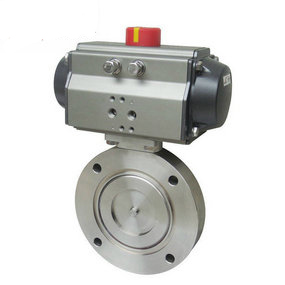How to install the pneumatic piston regulating butterfly valve? be careful:
1. The identification arrow on the upper side of the pneumatic ball valve must be consistent with the flow direction of the gas during operation;
2. In order to prevent foreign substances from flowing into the pneumatic ball valve during welding operation, the inner surface of the pneumatic ball valve is blocked with a packaging bag;
3. The pipe and pneumatic ball valve shall be welded horizontally and vertically;
4. It takes about 30 minutes for the welding machine to cool down after separation;
5. Take out the T-type pneumatic ball valve handle from the box, and insert the handle into the knob completely after assembly. Note: When using the "T" handle, test the on-off state of the pneumatic ball valve;
6. To confirm whether the pneumatic ball valve has on-off action: the length and direction of ADAPTER linear PE pipe of the pneumatic ball valve must be marked (-), which is open at this time. The linear vertical direction indicator (‖) is now closed. CLOSE: Turn ADAPTER 90 clockwise when it is on. Open (open): Turn ADAPTER 90 counterclockwise in the closed state. TOP ADAPTER of GEAR BOX? At about 180, the turning arrow 90 switch moves to the FULL CLOSE state, and the FULL OPEN state cannot be opened or closed vigorously.
7. Air tightness test using vent pneumatic ball valve;
8. Sand shall be laid around the knob of pneumatic ball valve.

The disadvantages are as follows:
1. Its regulating performance is worse than that of the stop valve, especially the pneumatic valve;
2. Because the main seat sealing ring material of pneumatic ball valve is polytetrafluoroethylene, it is inert to almost all chemicals. However, the physical characteristics of PTFE, including high expansion coefficient, sensitivity to cold flow and poor thermal conductivity, require that the design of valve seat seal must focus on these characteristics. When the sealing material becomes hard, the reliability of the seal will be damaged. Moreover, the temperature resistance grade of PTFE is low, and it can only be used at less than 180 ℃. Above this temperature, the sealing material will age. If long-term use is required, it is generally recommended to use it at 120 ℃; Advantages of pneumatic butterfly valve: 1. Convenient and quick opening and closing, labor saving, small fluid resistance, and frequent operation. 2. Simple structure, small size and light weight.
3. It is capable of transporting mud and storing little liquid at the pipe mouth.
4. Excellent sealing can be achieved under low pressure.
5. Good conditioning performance.




